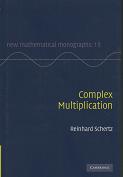Libros relacionados
 |
Fundamentos de Matemáticas, Álgebra, Trigonometría, Geometría Analítica y Cálcul Silva, Juan Manuel / Lazo, Adriana Limusa |
 |
Simulacion, Metodos y Aplicaciones. Rios Insua David/ Rios Insua Sixto/ Jimenez Jacinto Martin/ Alfaomega Grupo Editor S.A. de C.V. |
 |
Formulas y Tablas de Matematica Aplicada Spiegel, Murray R/ Lipschutz, Seymour/ Liu, John Mc Graw Hill Educacion |
 |
Dynamical Systems And Chaos. (Vol. 172) Broer, Henk; Takens, Floris Springer Science+business Media Inc. |


|
Título: Uncertainty Modeling In Dose Response | |
| Autor: Cooke Roger | Precio: $1375.00 | |
| Editorial: John Wiley & Sons Inc. | Año: 2009 | |
| Tema: Aplicaciones, Metodo de Prueba | Edición: 1ª | |
| Sinopsis | ISBN: 9780470447505 | |
| The goal of the book is to implement and compare different methods for quantifying the uncertainty in the probability of response, as a function of dose. Ultimately and ideally, this would be in a form compatible with integrated uncertainty analysis, comprising release, exposure, response, treatment cost, etc. In response to the fact that there remains no solution to the problem of quantifying uncertainty in dose response relations for toxic substances, the editor of this work has sought valuable contributions from the leaders in the field to properly tackle the issue. There is an urgent need to address the topic of uncertainty as it pertains to dose response modeling. To date, there is not even a systematic compendium of available methods, and there has been far too little systematic evaluation of the topic. This book analyzes four active substances that were vetted with the US EPA as representative of current problems. Leading contributors from the toxicology and risk assessment communities were invited to apply their methods to quantify model uncertainty in dose response for each case. The results they provided are very revealing of the properties, strengths, and weaknesses of the various approaches. In addition, all approaches were reviewed from three viewpoints: risk analyst / regulator; statistician / mathematician; and toxicologist / epidemiologist. The data sets in Chapters 2-4 are real and are proposed by the EPA as representative and relevant. In fact, each are so relevant that their names must be suppressed as each has a simple "uncertainty issue". Difficult extrapolations (subchronic-chronic, animal - human, precursor - endpoint ) are avoided. The subsequent analysis is hopefully rather straightforward, and the ultimate goal is to get the different methods known and available for further evaluation and discussion | ||
Librería Bonilla SA de CV © Todos los derechos reservados. 2019
Última actualización: Jul 2019





